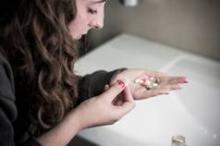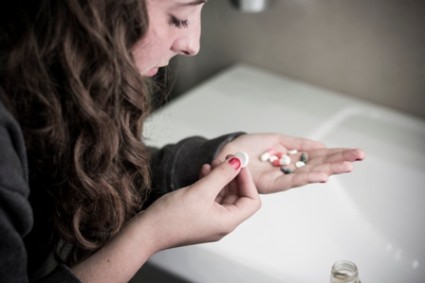User login
Six percent of adolescents aged 12-19 years self-reported that they had taken a psychotropic medication in the past month, but only half had seen a mental health professional in the last year.
That’s according to data extracted from the National Health and Nutrition Examination Survey (NHANES), which is partly based on interviews conducted with the subjects in their homes.
This particular report looked at psychotropic medication use among noninstitutionalized adolescents aged 12-19 years from 2005 to 2010. The estimates in the report are conservative because they do not include the homeless or adolescents who might be incarcerated or receiving inpatient treatment, according to the Bruce S. Jonas, Ph.D., Dr. Qiuping Gu, and Juan Albertorio-Diaz, all of whom are affiliated with the National Center for Health Statistics at the Centers for Disease Control and Prevention.
Among drug categories, antidepressants and medications for attention-deficit/hyperactivity disorder (ADHD) were the most common, with 3.2% of all adolescents reporting taking drugs for those two conditions. About 1% of adolescents reported using antipsychotics, and 0.5% reported use of anxiolytics, sedatives, or hypnotics. The rate of antimanic medication use – 0.2% – was considered to be an unreliable statistic, according to the authors.
Females were more likely to use antidepressants, while ADHD drug use was more common among males. Use of any psychotropic drug was highest among non-Hispanic white adolescents, with 8% reporting use, compared with 3% of non-Hispanic black adolescents and just under 3% of Mexican-American adolescents.
Some 5% of non-Hispanic white adolescents used antidepressants, compared with only 0.5% of non-Hispanic blacks and 0.7% of Mexican Americans. Four percent of non-Hispanic whites reported taking ADHD medications, while only about 2% of non-Hispanic blacks and Mexican Americans said they used drugs for that condition.
Survey participants also were asked whether they had seen or talked to a psychologist, psychiatrist, psychiatric nurse, or clinical social worker about their health in the past year. Overall, 53% said they had consulted such a professional. For those taking more than one medication, the figure rose to almost 80%.
The report, Data Brief No. 135, Psychotropic Medication Use Among Adolescents: United States, 2005–2010, can be found at the National Center for Health Statistics website.
On Twitter @aliciaault
Six percent of adolescents aged 12-19 years self-reported that they had taken a psychotropic medication in the past month, but only half had seen a mental health professional in the last year.
That’s according to data extracted from the National Health and Nutrition Examination Survey (NHANES), which is partly based on interviews conducted with the subjects in their homes.
This particular report looked at psychotropic medication use among noninstitutionalized adolescents aged 12-19 years from 2005 to 2010. The estimates in the report are conservative because they do not include the homeless or adolescents who might be incarcerated or receiving inpatient treatment, according to the Bruce S. Jonas, Ph.D., Dr. Qiuping Gu, and Juan Albertorio-Diaz, all of whom are affiliated with the National Center for Health Statistics at the Centers for Disease Control and Prevention.
Among drug categories, antidepressants and medications for attention-deficit/hyperactivity disorder (ADHD) were the most common, with 3.2% of all adolescents reporting taking drugs for those two conditions. About 1% of adolescents reported using antipsychotics, and 0.5% reported use of anxiolytics, sedatives, or hypnotics. The rate of antimanic medication use – 0.2% – was considered to be an unreliable statistic, according to the authors.
Females were more likely to use antidepressants, while ADHD drug use was more common among males. Use of any psychotropic drug was highest among non-Hispanic white adolescents, with 8% reporting use, compared with 3% of non-Hispanic black adolescents and just under 3% of Mexican-American adolescents.
Some 5% of non-Hispanic white adolescents used antidepressants, compared with only 0.5% of non-Hispanic blacks and 0.7% of Mexican Americans. Four percent of non-Hispanic whites reported taking ADHD medications, while only about 2% of non-Hispanic blacks and Mexican Americans said they used drugs for that condition.
Survey participants also were asked whether they had seen or talked to a psychologist, psychiatrist, psychiatric nurse, or clinical social worker about their health in the past year. Overall, 53% said they had consulted such a professional. For those taking more than one medication, the figure rose to almost 80%.
The report, Data Brief No. 135, Psychotropic Medication Use Among Adolescents: United States, 2005–2010, can be found at the National Center for Health Statistics website.
On Twitter @aliciaault
Six percent of adolescents aged 12-19 years self-reported that they had taken a psychotropic medication in the past month, but only half had seen a mental health professional in the last year.
That’s according to data extracted from the National Health and Nutrition Examination Survey (NHANES), which is partly based on interviews conducted with the subjects in their homes.
This particular report looked at psychotropic medication use among noninstitutionalized adolescents aged 12-19 years from 2005 to 2010. The estimates in the report are conservative because they do not include the homeless or adolescents who might be incarcerated or receiving inpatient treatment, according to the Bruce S. Jonas, Ph.D., Dr. Qiuping Gu, and Juan Albertorio-Diaz, all of whom are affiliated with the National Center for Health Statistics at the Centers for Disease Control and Prevention.
Among drug categories, antidepressants and medications for attention-deficit/hyperactivity disorder (ADHD) were the most common, with 3.2% of all adolescents reporting taking drugs for those two conditions. About 1% of adolescents reported using antipsychotics, and 0.5% reported use of anxiolytics, sedatives, or hypnotics. The rate of antimanic medication use – 0.2% – was considered to be an unreliable statistic, according to the authors.
Females were more likely to use antidepressants, while ADHD drug use was more common among males. Use of any psychotropic drug was highest among non-Hispanic white adolescents, with 8% reporting use, compared with 3% of non-Hispanic black adolescents and just under 3% of Mexican-American adolescents.
Some 5% of non-Hispanic white adolescents used antidepressants, compared with only 0.5% of non-Hispanic blacks and 0.7% of Mexican Americans. Four percent of non-Hispanic whites reported taking ADHD medications, while only about 2% of non-Hispanic blacks and Mexican Americans said they used drugs for that condition.
Survey participants also were asked whether they had seen or talked to a psychologist, psychiatrist, psychiatric nurse, or clinical social worker about their health in the past year. Overall, 53% said they had consulted such a professional. For those taking more than one medication, the figure rose to almost 80%.
The report, Data Brief No. 135, Psychotropic Medication Use Among Adolescents: United States, 2005–2010, can be found at the National Center for Health Statistics website.
On Twitter @aliciaault
Major finding: The top drug psychotropic drug classes adolescents report using are antidepressants and attention-deficit/hyperactivity disorder medications. The adolescents reported using medications in those two drug classes at the same rate: 3.2%.
Data source: The findings are based on self-reported data of U.S. noninstitutionalized adolescents, aged 12-19 years, during 2005-2010, from the National Health and Nutrition Examination Survey.
Disclosures: Dr. Jonas, Dr. Gu, and Mr. Albertorio-Diaz are affiliated with the National Center for Health Statistics at the CDC.

